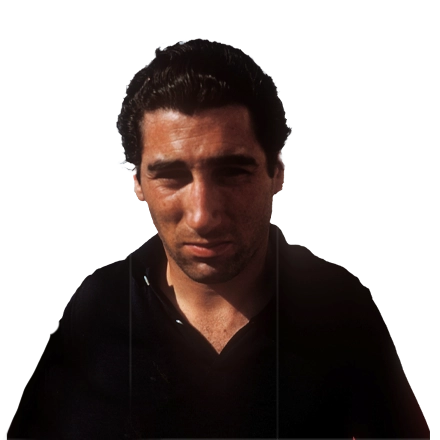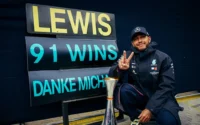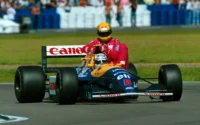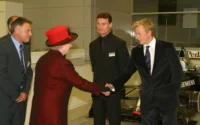Alfonso Antonio Vicente Eduardo Ángel Blas Francisco de Borja Cabeza de Vaca y Leighton, the 11th Marquess of Portago, better known as Alfonso de Portago, lived fast and died young. A Spanish aristocrat with movie-star looks and a taste for danger, he was a racing driver, bobsledder, steeplechase jockey, and pilot, a man seemingly allergic to moderation.
| Nationality | Spanish |
|---|---|
| Born | Alfonso Antonio Vicente Eduardo Ángel Blas Francisco de Borja Cabeza de Vaca y Leighton 11 October 1928 London, England |
| Died | Died 12 May 1957 (aged 28) Cavriana, Lombardy, Italy |
Born in London into one of Spain’s most distinguished noble families, Portago was literally named for royalty; his godfather was King Alfonso XIII. His lineage was steeped in prestige: his grandfather, the 9th Marquess of Portago, had served as Mayor of Madrid, while his father, President of Puerta de Hierro and a noted golfer, died dramatically mid-shower after a polo match. His mother, Olga Leighton, an Irish nurse, added a touch of grit and international flair to the family line.
By 17, Alfonso was already building his legend. On a dare, and a $500 bet, he borrowed a plane and flew it under London’s Tower Bridge, proving early that his appetite for risk was as large as his inheritance. He twice rode the Grand National as a “gentleman jockey,” and later formed Spain’s first-ever bobsleigh team with his cousins. They nearly took bronze at the 1956 Winter Olympics, missing third place by a hair’s breadth, just 0.14 seconds.
That same year, his need for speed found a new outlet: Scuderia Ferrari. Introduced to the team in 1953, Portago threw himself into the glamorous and perilous world of endurance and Grand Prix racing. He competed in the Carrera Panamericana, the 1000 km of Buenos Aires, and several Grand Prix, snagging a victory at the 1956 Tour de France Automobile and finishing second at the 1956 British Grand Prix.
But his meteoric rise met a tragic end. During the 1957 Mille Miglia, racing his Ferrari 335 S at nearly 150 mph (240 km/h) on a dead-straight road near the Italian village of Guidizzolo, a tyre burst, and in an instant, it was over. The crash killed Portago, his co-driver Edmund Nelson, and nine spectators. The Marquess was only 28. The world mourned not just a driver, but an icon, a man whose blend of charm, courage, and recklessness made him one of the era’s defining figures. Tributes soon followed, from race circuits to memorials, including the famous “Portago Curve” at Jarama racetrack.
Portago was the archetype of the mid-century playboy, “a tall, handsome, and wealthy Spanish aristocrat who captured everybody’s imagination.” Motorsport writer Gregor Grant summed him up best: “A man like Portago appears only once in a generation — no, once in a lifetime. He did everything superbly: racing, bobsledding, riding, speaking four languages fluently… he could have been the best at anything he chose, soldier, bridge player, even writer.”
The Fatal Mille Miglia
On 12 May 1957, Alfonso de Portago and Edmund Nelson were charging through the final leg of the Mille Miglia, a 1,000-mile dash across Italy. Their Ferrari 335 S was running third overall, slicing through the countryside between Cerlongo and Guidizzolo, about 70 km from Brescia. Portago, ever conscious of danger, had called the Mille Miglia “too risky”, an impossible challenge given the unpredictable corners, road surfaces, and sheer distance. His instincts were right.
Travelling at 240 km/h (150 mph), a front tyre burst. The Ferrari veered, struck the crowd, and disintegrated. Nine spectators were killed, five of them children, some struck by a milestone post torn from the ground by the impact. Portago’s car vaulted a canal, rebounded, and came to rest in ruin. Both he and Nelson were killed instantly, their bodies mangled beyond recognition.
Moments earlier, photographers had captured what became one of racing’s most haunting images: “The Kiss of Death”, Portago kissing actress Linda Christian at a stop before rejoining the race. As journalist T.C. Browne later wrote, “The inevitable happened when Alfonso de Portago stopped to kiss Linda Christian, ran back to his Ferrari, and drove on to his destiny, killing himself, his co-driver, ten spectators, and the Mille Miglia.”
Ironically, Portago had once joked, “I won’t die in an accident. I’ll die of old age, or be executed in some gross miscarriage of justice.” His co-driver, Nelson, had replied that Portago would never reach thirty. He was right.
Legacy
Portago’s death marked the end of an era, both for the Mille Miglia and for a certain kind of fearless glamour. He was mourned as much for his charisma as for his courage.
His name lives on in tributes across motorsport: a Portago Curve at Spain’s Jarama circuit, and another at the legendary St. Moritz–Celerina Olympic Bobrun, recognising his contribution to restoring the track. At the crash site in Cavriana, a memorial stands to honour the victims of that tragic day, a monument to both speed and its terrible cost.
In life, Alfonso de Portago was the embodiment of daring elegance, a man who raced the clock and lost, but only just.
Alfonso de Portago Formula One World Championship career
| F1 Career | 1956 – 1957 |
|---|---|
| Teams | Ferrari |
| Entries | 5 |
| Championships | 0 |
| Wins | 0 |
| Podiums | 1 |
| Career points | 4 |
| Pole positions | 0 |
| Fastest laps | 0 |
| First entry | 1956 French Grand Prix |
| Last entry | 1957 Argentine Grand Prix |
Alfonso de Portago Teammates
| 9 drivers | Involvement | First Year | Last Year |
|---|---|---|---|
| Peter Collins | 5 | 1956 | 1957 |
| Olivier Gendebien | 2 | 1956 | |
| Juan Manuel Fangio | 4 | 1956 | |
| Eugenio Castellotti | 5 | 1956 | 1957 |
| Luigi Musso | 3 | 1956 | 1957 |
| Wolfgang von Trips | 2 | 1956 | 1957 |
| Mike Hawthorn | 1 | 1957 | |
| Cesare Perdisa | 1 | 1957 | |
| Jose Froilan Gonzalez | 1 | 1957 |
Alfonso de Portago Complete Formula One Results
| Year | Entrant | Chassis | Engine | 1 | 2 | 3 | 4 | 5 | 6 | 7 | 8 | WDC | Points |
|---|---|---|---|---|---|---|---|---|---|---|---|---|---|
| 1956 | Scuderia Ferrari | Ferrari D50 | Ferrari V8 | ARG | MON | 500 | BEL | FRA Ret | GBR 2 † | GER Ret | ITA Ret | 15th | 3 |
| 1957 | Scuderia Ferrari | Ferrari D50A | Ferrari V8 | ARG 5 * | MON | 500 | FRA | GBR | GER | PES | ITA | 20th | 1 |
* Indicates shared drive with José Froilán González





